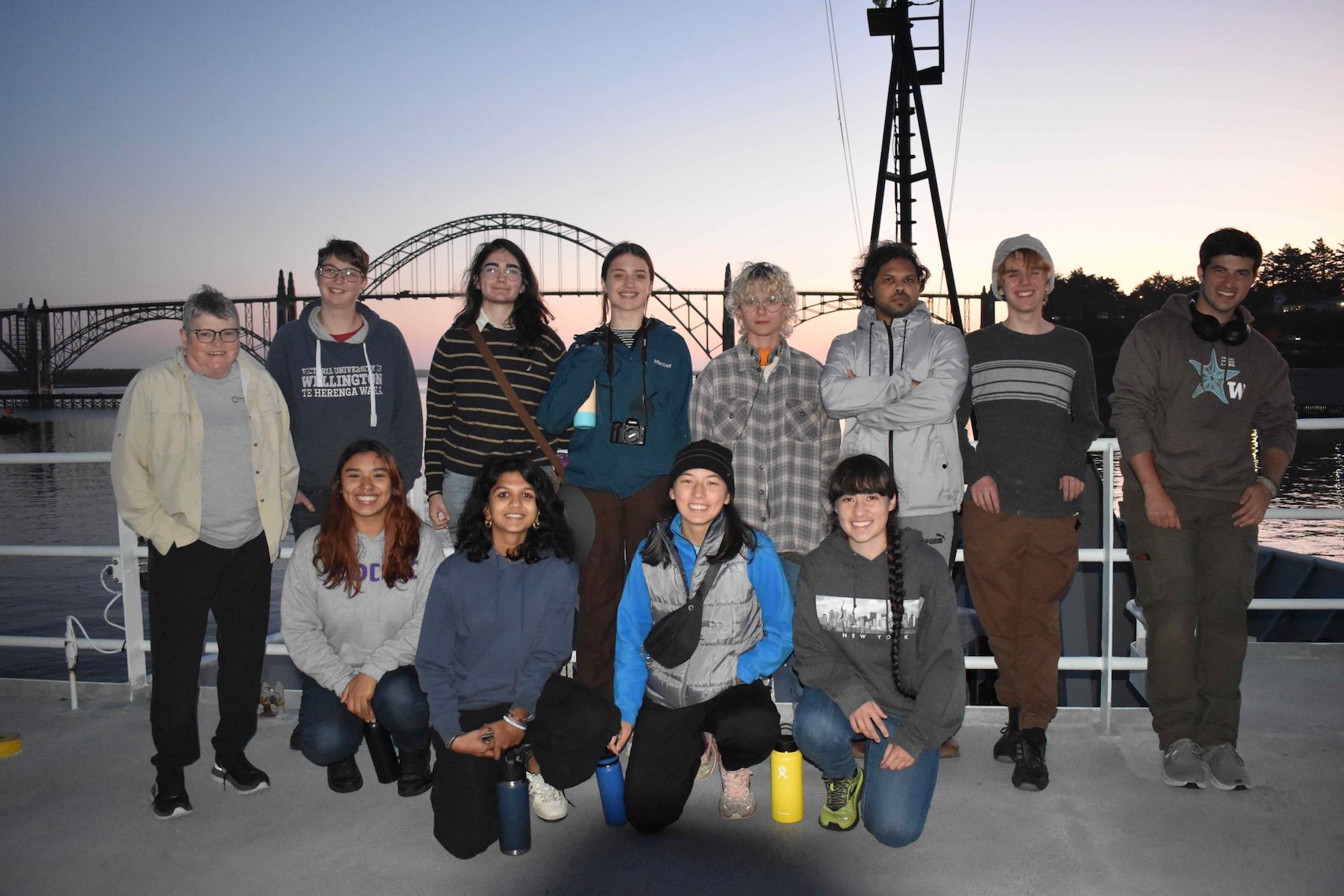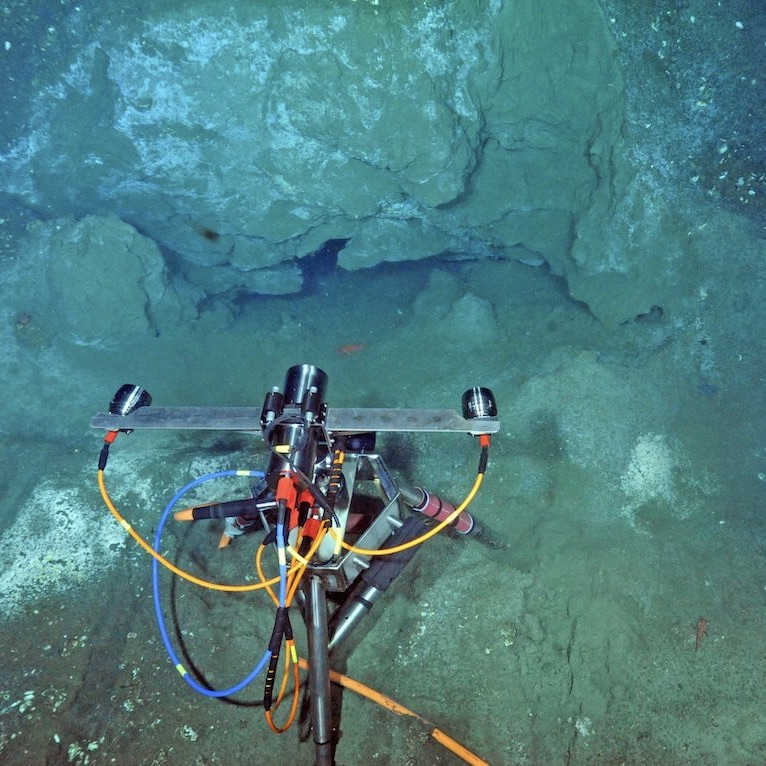A Post Doc Project with Ten Years of Ready-made Data
Katie Bigham has been around OOI for nearly a decade. Her involvement began in 2014 when she was an undergraduate at the University of Washington (UW) and took part in the marathon 83-day OOI Regional Cabled Array’s (RCA) final construction cruise that installed over 100 instruments, 9 moorings, 18 junction boxes and thousands of meters of extension cables. At the time, she was onboard as part of UW’s VISIONS program, an at-sea education program designed for students to experience all aspects of seagoing research and life aboard a global class oceanographic research vessel hosting a remotely operated vehicle (ROV). With a taste of Axial Seamount and hydrothermal vents on the ocean floor provided by her first sea-going experience, Katie landed on a direct career path to where she is today — a benthic ecologist post-doc at UW, using OOI data. It’s a repeat pattern for Katie. She first used RCA OOI data to write her senior thesis focused on life thriving at Southern Hydrate Ridge methane seeps before graduating with a degree in Oceanography from UW in 2017.

After graduation, Katie took a couple of gap years, where she worked as a research associate for the OOI RCA and continued to go out on RCA’s annual recovery and deployment expeditions. She then decided to go for a PhD, relocating to Victoria University of Wellington in New Zealand during the height of COVID. While other colleagues’ research was stymied by the effects of the worldwide lockdown, Katie, luckily, had access to years of data on benthic communities in Kaikōura Canyon, a highly productive submarine canyon. As a benthic ecologist, she is interested in how and why biological communities change over time. Her dissertation focused on the impact of the magnitude 7.8 Kaikōura Earthquake in 2016 on the benthic community and it’s recovery. To assess this, she used co-registered detailed bathymetric and multicore data, as well as repeat photographic surveys from both before and after the disturbance.
“For a lot of these deep communities, we don’t really know what the baseline is for them. We don’t know what normal is,” Katie said. “I’m really interested in how to get the most out of multiscale, complex data sets to answer these important questions. Ship time is expensive. It’s hard to work in the deep sea and conditions there are really tough on instruments and equipment. That’s why projects like OOI are a great way to provide critical data over the long haul.”
During her PhD, Katie applied for and was awarded a National Science Foundation Postdoctoral Research Fellowship within the Ocean Sciences Division. “Funny, but my original thought was to try to Pandemic-proof my post-doc. I wanted to formulate a project that would advance our knowledge of benthic communities thriving in dynamic environments and be achievable in a 2-year time period. I was looking for something that would be cohesive and with readily available data that wouldn’t be at risk from COVID impacts, such as requiring laboratory studies. After considering available datasets, from my senior thesis work, I remembered the tens of thousands of images and terabytes of video collected at Southern Hydrate Ridge (SHR) since 2008 during the early days of the RCA and follow-on annual cruises, as well as the now nearly decade of data provided by the cabled instrumentation. Using these data, I was able to immediately start asking questions about long term temporal changes in biological communities associated with methane seeps. The wealth of high quality imagery collected at SHR, is nearly unparalleled for these environments.”
Katie is using imagery from the SHR digital still camera and ROV imagery for her research project. The cabled camera located at the Einsteins’ Grotto methane seep turns on its lights every half hour, takes three pictures, and then turns off. “It’s a highly dynamic environment where we’ve seen significant changes since the camera and the other equipment was first put in place there. This site hosts ‘vagrants’ or non-endemic megafauna, along with chemosynthetic bacteria that form extensive mats and clams with symbiotic bacteria. But, we also see rockfish, flounders, hagfish, eelpouts, and other visitors that come into the area, as well as soft corals and Neptunea nurseries because we think the seep is acting as a kind of an oasis for these organisms.”

The visual imagery available is helping Katie better understand cold seeps and how and why they are attracting other species. “Better understanding of methane seeps is important because of the potential interest in mining them, and because places like SHR are deemed “essential fish habitats.” Hence, we need to understand their relevance to fish stocks, including that perhaps they may be serving as nursery areas. Over 1,000 sites along the Cascade Margin are known to venting methane, but less than ~five have been studied in any detail.”
The imagery allows researchers like Katie to begin to look at the temporal dynamics of these communities and determine whether they respond to particular cycles, such as tides, changes in the chemosynthetic concentrations, or pulses of macroalgae from the surface, as well as the long term impacts of ocean warming. “The images are helping us understand the colonization of specific organism types and how benthic communities are using these sites over time. Because the datasets are so high-resolution with data every half hour, we can look at larger annual cycles and changes from season to season and year to year,” Katie added. Other SHR co-located cabled instrumentation also allows for investigation of changing conditions due to seismic events, for example.
The Challenges of Big Data
Katie’s task over the next two years is not an easy one. The digital still camera alone produces over 50,000 images a year. These data, coupled with terabytes of 4K and HD imagery, as well as thousands of images taken during ROV dives in the area, creates a huge amount of imagery to process. She’s tackling this effort in two stages: The first is to bring in machine learning and computer vision techniques to aggregate the datasets. Once that is accomplished, there’s the bigger task of looking at the imagery and classification output to determine what can be learned about the inhabitants of the seep area.
The first task to incorporate AI into helping sort the imagery is to label various features. “Obviously, the holy grail would be, the computer just does it for you. But because this still camera is looking at generally the same scene all the time, it’s ripe for putting an event detector or machine assisted annotation, where the computer can help differentiate today’s picture from yesterday’s picture,” she added. With such computerized assistance, researchers like Katie can then spend their time looking at the animals and observing their behavior rather than having to annotate each image. She gave an example: sometimes a crab will find a home on the camera and hang out there, blocking images of the area. A computer “trained to identify when this happens,” could allow researchers to avoid this occurrence when they can’t see behind the crab.
“I’m super stoked about this project. It’s been an exciting thing to be working on and it’s been really cool to bring together my scientific background and access to RCA-OOI data,” Katie said. “I’m developing automated digital analyses techniques that when I worked on my undergraduate thesis thought it’d be so cool to do and I’m doing it now.”
With a powerful computer and multiple monitors in hand, in two years when her post doc ends (December 2025), Katie will have moved the world of AI forward to analyze an unprecedented amount of data within this marine ecosystem, resulting in one or more scientific papers about the temporal dynamics of benthic communities and how and why they change over time–in her words “a nice, cohesive, achievable effort!”

